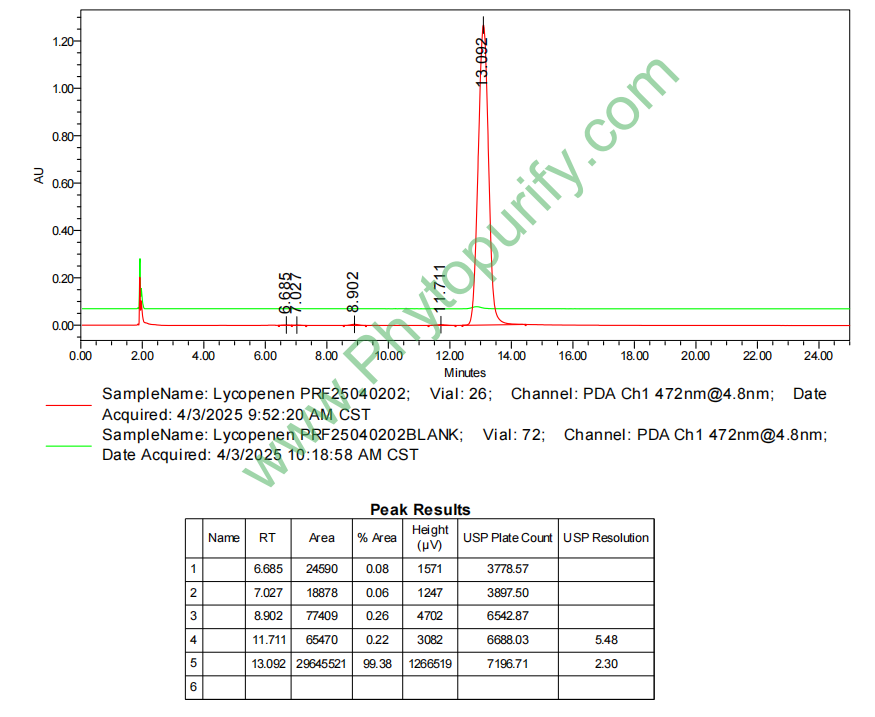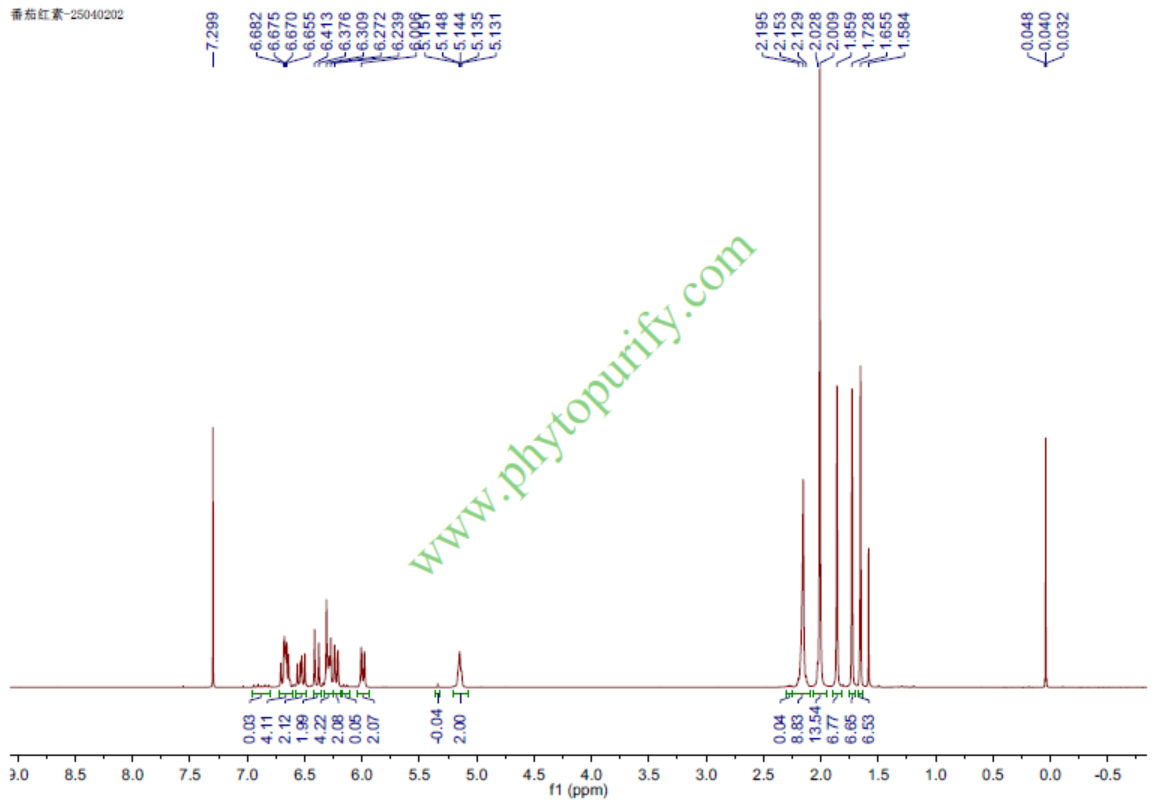
LycopeneCAS No.:502-65-8
|
||||||||||
 |
|
|
||||||||

| Catalogue No.: | BP0901 |
| Formula: | C40H56 |
| Mol Weight: | 536.888 |
Product name: Lycopene
Synonym name: Tomato lycopene
Catalogue No.: BP0901
Cas No.: 502-65-8
Formula: C40H56
Mol Weight: 536.888
Botanical Source: Lycopersicon esculentum Mill.
Physical Description:
Type of Compound: Miscellaneous
Purity: 95%~99%
Analysis Method: HPLC-DAD or/and HPLC-ELSD
Identification Method: Mass, NMR
Packing: Brown vial or HDPE plastic bottle
Storage: Store in a well closed container, protected from air and light. Put into refrigerate or freeze for long term storage.
Whenever possible, you should prepare and use solutions on the same day. However, if you need to make up stock solutions in advance, we recommend that you store the solution as aliquots in tightly sealed vials at -20℃. Generally, these will be useable for up to two weeks.
The product could be supplied from milligrams to grams
Inquire for bulk scale.
Description:
Lycopene is the pigment principally responsible for the characteristic deep-red color of ripe tomato fruits and tomato products. Lycopene is an antioxidant scavenger, hypolipaemic agent, inhibitor of pro-inflammatory and pro-thrombotic factors, thus potentially of benefit in cardiovascular disease (CVD). Lycopene may play a role in the prevention of Renal cell carcinoma, it also may play a role against obesity-related complications.
References:
Clin Exp Pharmacol Physiol. 2015 Jun;42(6):632-9.
Lycopene inhibits cyclic strain-induced endothelin-1 expression through the suppression of reactive oxygen species generation and induction of heme oxygenase-1 in human umbilical vein endothelial cells.
Lycopene is the most potent active antioxidant among the major carotenoids, and its use has been associated with a reduced risk for cardiovascular disease (CVD). This study investigated the effects of Lycopene on cyclic strain-induced ET-1 gene expression in human umbilical vein endothelial cells (HUVECs) and identified the signal transduction pathways that are involved in this process.
METHODS AND RESULTS:
Cultured HUVECs were exposed to cyclic strain (20% in length, 1 Hz) in the presence or absence of Lycopene. Lycopene inhibited strain-induced ET-1 expression through the suppression of reactive oxygen species (ROS) generation through attenuation of p22(phox) mRNA expression and NAD(P)H oxidase activity. Furthermore, Lycopene inhibited strain-induced ET-1 secretion by reducing ROS-mediated extrace-llular signal-regulated kinase (ERK) phosphorylation. Conversely, Lycopene treatment enhanced heme oxygenase-1 (HO-1) gene expression through the activation of phosphoinositide 3-kinase (PI3K)/Akt pathway, followed by induction of the nuclear factor erythroid 2-related factor 2 (Nrf2) nuclear translocation; in addition, HO-1 silencing partially inhibited the repressive effects of Lycopene on strain-induced ET-1 expression.
CONCLUSIONS:
In summary, our study showed, for the first time, that Lycopene inhibits cyclic strain-induced ET-1 gene expression through the suppression of ROS generation and induction of HO-1 in HUVECs.Therefore, this study provides new valuable insight into the molecular pathways that may contribute to the proposed beneficial effects of Lycopene on the cardiovascular system.
Ultrason Sonochem. 2015 Nov;27:586-591.
Effect of high power low frequency ultrasound processing on the stability of lycopene.
The stability of Lycopene was evaluated after application of high power low frequency ultrasound.
METHODS AND RESULTS:
The study was carried out on a solution containing pure Lycopene to evaluate the direct effect of ultrasound on Lycopene and on tomato purée to evaluate the direct and indirect effects of ultrasound application within a food matrix. Power densities ranging from 55 to 5000 W/L and temperatures ranging from 23°C (ambient) to 60°C were evaluated. The experiments on pure Lycopene showed that the application of ultrasound did not have any direct effect over Lycopene. However, the retention of Lycopene in tomato puree has decreased indicating an indirect effect on Lycopene stability caused by high concentration of hydrogen peroxide and the activation of peroxidase enzymes leading to the reduction of ascorbic acid and its regenerative action towards Lycopene.
Curr Med Chem. 2011;18(8):1146-63.
Lycopene and cardiovascular diseases: an update.
Cardiovascular disease (CVD) is the leading cause of death in Western societies and accounts for up to a third of all deaths worldwide. In comparison to the Northern European or other Western countries, the Mediterranean area has lower rates of mortality from cardiovascular diseases and cancer, and this is attributed, at least in part, to the so-called Mediterranean diet, which is rich in plantderived bioactive phytochemicals. Identification of the active constituents of the Mediterranean diet is therefore crucial to the formulation of appropriate dietary guidelines.
METHODS AND RESULTS:
Lycopene is a natural carotenoid found in tomato, an essential component of the Mediterranean diet, which, although belonging to the carotenoid family, does not have pro-vitamin A activity but many other biochemical functions as an antioxidant scavenger, hypolipaemic agent, inhibitor of pro-inflammatory and pro-thrombotic factors, thus potentially of benefit in CVD. In particular, the review intends to conduct a systematic analysis of the literature (epidemiological studies and interventional trials) in order to critically evaluate the association between Lycopene (or tomato products) supplementation and cardiovascular diseases and/or cardiovascular disease risk factors progression, and to prepare provision of evidence-based guidelines for patients and clinicians. Several reports have appeared in support of the role of Lycopene in the prevention of CVD, mostly based on epidemiological studies showing a dose-response relationship between Lycopene and CVD. A less clear and more complex picture emerges from the interventional trials, where several works have reported conflicting results.
CONCLUSIONS:
Although many aspects of Lycopene in vivo metabolism, functions and clinical indications remain to be clarified, supplementation of low doses of Lycopene has been already suggested as a preventive measure for contrasting and ameliorating many aspects of CVD.
HPLC of Lycopene

HNMR of Lycopene
